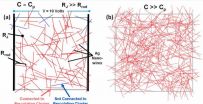(Press-News.org) At the forefront of a field known as "neurocriminology," Adrian Raine of the University of Pennsylvania has long studied the interplay between biology and environment when it comes to antisocial and criminal behavior. With strong physiological evidence that disruption to the emotion-regulating parts of the brain can manifest in violent outbursts, impulsive decision-making and other behavioral traits associated with crime, much of Raine's research involves looking at biological interventions that can potentially ward off these behavioral outcomes.
A new study by Raine now suggests that omega-3, a fatty acid commonly found in fish oil, may have long-term neurodevelopmental effects that ultimately reduce antisocial and aggressive behavior problems in children.
He is a Penn Integrates Knowledge Professor with appointments in the School of Arts & Sciences and the Perelman School of Medicine.
Along with Raine, the study featured Jill Portnoy a graduate student in the Department of Criminology, and Jianghong Liu, an associate professor in the Penn School of Nursing. They collaborated with Tashneem Mahoomed of Mauritius' Joint Child Health Project and Joseph Hibbeln of the National Institute on Alcohol Abuse and Alcoholism.
It was published in the Journal of Child Psychology and Psychiatry.
When Raine was a graduate student, he, his advisor and colleagues conducted a longitudinal study of children in the small island nation of Mauritius. The researchers tracked the development of children who had participated in an enrichment program as 3-year-olds and also the development of children who had not participated. This enrichment program had additional cognitive stimulation, physical exercise and nutritional enrichment. At 11 years, the participants showed a marked improvement in brain function as measured by EEG, as compared to the non participants. At 23, they showed a 34 percent reduction in criminal behavior.
Raine and his colleagues were interested in teasing apart the mechanisms behind this improvement. Other studies suggested the nutritional component was worth a closer look.
"We saw children who had poor nutritional status at age 3 were more antisocial and aggressive at 8, 11 and 17," Raine said. "That made us look back at the intervention and see what stood out about the nutritional component. Part of the enrichment was that the children receiving an extra two and a half portions of fish a week."
Other research at the time was beginning to show that omega-3 is critical to brain development and function.
"Omega-3 regulates neurotransmitters, enhances the life of a neuron and increases dendritic branching, but our bodies do not produce it. We can only get it from the environment," Raine said.
Research on the neuroanatomy of violent criminals suggested this might be a place to intervene. Other brain-imaging researchers have shown that omega-3 supplementation increases the function of the dorsolateral prefrontal cortex, a region Raine found to have higher rates of damage or dysfunction in criminal offenders.
Raine's new study featured a randomized controlled trial where children would receive regular omega-3 supplements in the form of a juice drink. One hundred children, aged 8 to 16, would each receive a drink containing a gram of omega-3 once a day for six months, matched with 100 children who received the same drink without the supplement. The children and parents in both groups took a series of personality assessments and questionnaires at the start.
After six months, the researchers administered a simple blood test to see if the children in the experimental group had higher levels of omega-3 than those in the controls. They also had both parents and children take the personality assessments. Six months after that, the researchers had parents and children take the assessment again to see if there were any lasting effects from the supplements.
The assessments had parents rate their children on "externalizing" aggressive and antisocial behavior, such as getting into fights or lying, as well as "internalizing" behavior, such as depression, anxiety and withdrawal. Children were also asked to rate themselves on these traits.
While the children's self-reports remained flat for both groups, the average rate of antisocial and aggressive behavior as described by the parents dropped in both groups by the six-month point. Critically, however, those rates returned to the baseline for the control group but remained lowered in the experimental group, at the 12-month point.
"Compared to the baseline at zero months," Raine said, "both groups show improvement in both the externalizing and internalizing behavior problems after six months. That's the placebo effect.
"But what was particularly interesting was what was happening at 12 months. The control group returned to the baseline while the omega-3 group continued to go down. In the end, we saw a 42 percent reduction in scores on externalizing behavior and 62 percent reduction in internalizing behavior."
At both the six- and 12-month check-ins, parents also answered questionnaires about their own behavioral traits. Surprisingly, parents also showed an improvement in their antisocial and aggressive behavior. This could be explained by the parents taking some of their child's supplement, or simply because of a positive response to their child's own behavioral improvement.
The researchers caution that this is still preliminary work in uncovering the role nutrition plays in the link between brain development and antisocial behavior. The changes seen in the one-year period of the experiment may not last, and the results may not be generalizable outside the unique context of Mauritius.
Beyond these caveats, however, there is reason to further examine omega-3's role as a potential early intervention for antisocial behavior.
"As a protective factor for reducing behavior problems in children," Liu said, "nutrition is a promising option; it is relatively inexpensive and can be easy to manage."
Follow-up studies will include longer-term surveillance of children's behavioral traits and will investigate why their self-reports did not match the parental reports.
INFORMATION:
Smartfish provided the juice drinks used in the study as well as a grant that supported research staff in Mauritius. Other support came from the National Institutes of Health through the Intramural Research Program of the National Institute on Alcohol Abuse and Alcoholism and from the University of Pennsylvania.
An article, "Smaller amygdala and medial prefrontal cortex predict escalating stimulant use," published online on May 13 in Brain: A Journal of Neurology has found that individual differences in brain structure could help to determine the risk for future drug addiction. The study found that occasional users who subsequently increased their drug use compared with those who did not, showed brain structural differences when they started using drugs.
In the two studies, researchers, led by Dr. Benjamin Becker, scanned the brain structure of 66 participants to provide the ...
NEW YORK, May 15, 2015 -- National thought leaders convened at Columbia University's Mailman School of Public Health yesterday for a symposium identifying gaps in understanding the prevention of sexual violence on college campuses, calling for a broad interdisciplinary agenda for the next generation of research on a significant problem that became front-page news around the country this year.
The day-long event, "Transforming the Campus Climate: Interdisciplinary Perspectives on Sexual Violence," was one of the first public activities sponsored by the Sexual Health Initiative ...
The future of communities around the world will in large part be determined by the efforts to achieve a high quality of life for their older citizens, according to the latest issue of Public Policy & Aging Report (PP&AR), titled "Making a Home in the City: The Age-Friendly Community Movement." A total of seven articles argue that developing cities that meet the interests of all generations should be an important goal for economic and social policy.
"The concomitant growth of cities and of an older population within those cities has come to generate a disjuncture between ...
Boulder, Colo., USA - California and other parts of the western U.S. are experiencing extended severe drought conditions. Varying groundwater levels in valleys throughout the state, balanced by water imported, for instance, via the State Water Project and the federal Central Valley Project make understanding the state's underlying hydrologic framework all the more important. This paper by R.T. (Randy) Hanson of the U.S. Geological Survey focuses on California's Santa Clara Valley.
In the introduction to his paper, Hanson provides a succinct history of the area, as paraphrased ...
Researchers at Lehigh University have identified for the first time that a performance gain in the electrical conductivity of random metal nanowire networks can be achieved by slightly restricting nanowire orientation. The most surprising result of the study is that heavily ordered configurations do not outperform configurations with some degree of randomness; randomness in the case of metal nanowire orientations acts to increase conductivity.
The study, Conductivity of Nanowire Arrays under Random and Ordered Orientation Configurations, is published in the current issue ...
1. The "Radial Paradox": Higher Femoral Access Site Complications Offsets Radial Benefits
Growing acceptance of radial access during cardiac catheterisation to reduce access site complications may contribute to a loss of experience with femoral access, potentially increasing vascular complications when the femoral technique is used. Montreal Heart Institute researchers compared contemporary and historical patient cohorts (n=17,059) and found that vascular access complications today, using the femoral artery approach--used typically as a back-up method--are more common ...
No one health issue has the most impact on human health, or engenders more debate about how to tackle it, than obesity.
It has become the scourge of the health agenda, especially in the west, and it is a growing problem. According to the latest figures from the World Health Organisation, almost three-quarters of British men and two-thirds of women will be overweight or obese by 2030 - a staggering 39 million adults in total. We have one of the worst obesity records in Europe, with just six of the 52 countries in the WHO's European region with worse obesity rates for women.
We ...
Spider silk has long been noted for its graceful structure, as well as its advanced material properties: Ounce for ounce, it is stronger than steel.
MIT research has explained some of the material's mysteries, which could help design synthetic resources that mimic the extraordinary properties of natural silk. Now, scientists at MIT have developed a systematic approach to research its structure, blending computational modeling and mechanical analysis to 3D-print synthetic spider webs. These models offer insight into how spiders optimize their own webs.
"This is the ...
This news release is available in Spanish. The mission of neural stem cells located in the hippocampus, one of the main regions of the brain, is to generate new neurons during the adult life of mammals, including human beings, of course, and their function is to participate in certain types of learning and responses to anxiety and stress. Using an epilepsy model in genetically modified mice, the researchers have discovered that hippocampal neural stem cells stop generating new neurons and are turned into reactive astrocytes, a cell type that promotes inflammation and ...
A research team based at the University of Eastern Finland and the Turku Centre for Biotechnology have found new ways to block a pathway that may be responsible for several brain disorders, which could open the door to developing better treatments.
The protein NOS-1 generates nitric oxide, a chemical signal that is linked to neurological disorders from neurodegeneration, stroke and chronic pain sensitivity to anxiety and depressive disorders. These are now among the most common causes of disability and mortality, but decades of efforts have not led to a safe drug that ...

